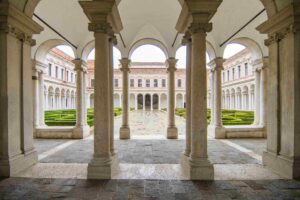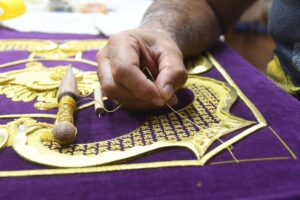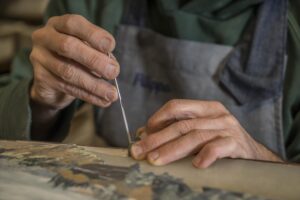Alberto Cavalli General Director of Homo Faber discusses this year’s event and how it celebrates the beauty of craftsmanship.

Fondazione Giorgio Cini© Fondazione Giorgio Cini
This year, Homo Faber, a cultural event dedicated to the beauty of contemporary craftsmanship returns for its second edition in Venice and it’s set to be the most exciting one yet. This year’s event which is organised by the Michelangelo Foundation for Creativity and Craftsmanship is titled “living treasures of Europe and Japan” and is dedicated to handmade crafts from these two destinations. Taking place at Venice’s iconic Fondazione Giorgio Cini, it will be home to 15 exhibition spaces, each dedicated to different aspects of craftsmanship. Here we discover more with the General Director of Homo Faber, Alberto Cavalli.

Alberto Cavalli Executive Director Laila Pozzo ©Michelangelo Foundation
Tell us a little about this year’s edition of Homo Faber exhibition, what can we expect and what are some of the highlights to look out for this year?
Homo Faber will be an event that celebrates the master of craftsmanship with a special focus on what we call the “living treasures”. It will be focused on European fine craftsmanship, but this year, our curators scoured the world for exceptional artisans and it drew them to Japan. In Japan, both seasoned masters and rising stars express and manifest a very contemporary vision and the idea of the role and the value crafts in our contemporary life. And this is why Japan is the guest of honour of this edition.
Since 1950 in Japan a group of gifted human beings who are holders of intangible know-how of Japanese traditional crafts were named “National Living Treasures.” And we liked the idea of celebrating human beings as treasures. Treasures are normally hidden and not easy to find, but they are very precious. They give value to the territory and to whoever encounters them. We have worked with some Japanese curators to have a selection of these Japanese national living treasures. In particular, we have worked with Naoto Fukasawa who is an architect and designer who has conceived the most beautiful set-up in one of the rooms where Homo Faber will be staged to celebrate twelve objects crafted by twelve living treasures.
The magnificent location of the event is already a discovery in itself. I think it’s the most photographed place on earth, but not a lot of people know what’s going on inside, so we are opening the whole foundation including spaces that are normally not accessible to the public, to create this kaleidoscope of exhibitions, each of which has been imagined and developed by a curator with an architect or designer. We have a team of curators over five continents and they have all brought great value to the project because they have allowed us to multiply the points of view. We believe that in contemporary times, to arrive at such an event offering a monolithic vision would be of no interest to anyone. While the fact of having all of these visions, perceptions, inspirations and points of view, all the different facets that the craft takes on contemporary life, Homo Faber will be a celebration of all of this and hopefully we will not only inspire new vocations but also surprise our visitors in a positive way by showcasing and demonstrating that there are and will always be something that human hands can do better than any machine.

At a time when technology is leading the way what in your opinion is the importance of sustaining traditional crafts in art and culture and how do you promote that to the younger generations?
We believe that technology is a very powerful and important instrument for artisans. Think about all the opportunities that digital communication can offer to master craftsmen who are very often tucked away in their own territories and not so visible to the rest of the world. Digital communication is of huge help. So if you look at the digital revolution from this perspective, it can only bring good to the master artisans. We believe that the true enemy is not technology, it’s ignorance and not acknowledging the fact that what humans do and their talent makes a difference in the world.
We believe on the contrary that the young generations are particularly interested in this. Unlike my generation, they have grown up knowing that the future is not necessarily a promise, but very often a threat. And they know that they have to take care of this to treasure the resources and to enjoy a new way of creating, producing, selling and exchanging. So there is already an interest that we will certainly try to channel into Homo Faber and on top of this, there is the idea that the more digital our lives become, the more analogue our dreams are. If you look at some of the world’s biggest tycoons, they live in the digital world, yes, but they wear an analogue watch. So there is always a part of us that needs to dream through something made for us with a purpose and Homo Faber will be showcasing this.
We are working with the new generations and we are offering visibility to young and upcoming designers who will be present as exhibitors, but also we are targeting an even younger audience. We have partnerships with schools and colleges around the world and we are ready to welcome an exchange with the younger generation and many of our exhibitions will be very immersive for them to enjoy.
We have 100 young ambassadors from across Europe. They are all school leavers from some of the best schools in arts and crafts and they will come to Venice to be the ones who show guests around, describing all the objects and installations to visitors. There is value in forming a community these days and this is a community of the makers of the future.
How do you think the event can resonate with people in the Middle East and is there any potential to bring the event to the region in the future?
I think it can resonate in a number of ways. The first and most obvious is that in the Middle East there are a lot of commissioners. By that, I mean people with good taste who are extremely interested in the work of the master artisans throughout the world. So there are a lot of opportunities. A master artisan can make his or her job viable if they have commissions. So it’s extremely important to work on this and to inspire people with the offering of having something special made for them in a certain way. With all the beautiful and impressive architectural development in the Middle East, it is becoming the new cradle of the commissioners of tomorrow. Because there is nowhere else in the world, that I know of, where there is this bustling activity of creating not only homes but meaningful and beautiful buildings whose interiors have to reflect personalities, dreams and hopes. So on top of the land of making is the land of dreams, and dreams will become projects.
Aside from this though we have the Homo Faber Guide which is our online tool that will soon be open to non-European countries. I’m quite positive about the fact that the United Arab Emirates will soon join. We will have a little taster of this coming up soon but I can’t tell you anything more yet!

Fondazione Giorgio Cini Simone Padovani ©Michelangelo Foundation
Can you tell us a little more about the Homo Faber Guide?
Imagine you are a third-generation silversmith in a little village in Kazakhstan. All of your friends are moving out of the village to open their own businesses but you stay there and you are regarded as someone who is not going anywhere. But all of a sudden you are featured in the Homo Faber Guide which is an internationally acknowledged instrument of discovery of the living treasures and suddenly you are the embodiment of a success story from that small village that will attract interest, attention and value to your country.
On top of what we do and the artisans that we feature, there is a constellation of other artisans that might look at what we do and find comfort in knowing that they are seen, heard and taken care of. Many of the artisans that we feature don’t normally even have a website or social media, so the Homo Faber Guide is their way of being present around the world. If what we do can help these people to reaffirm that the choices they made were the right ones, then we have done our job.
Venice itself is a living museum, what does this beautiful city mean to you and why is it important to hold this event there?
Venice is a handmade city. It’s floating and it’s a city without walls. If you think about it, the most beautiful facades of Venice open onto the lagoon so it has no way of defending itself apart from with its beauty and its meaning. These are the only weapons it has to survive. It has always been the place where anyone who has something beautiful, meaningful or new could come. It’s the city of art and commerce, of merchants, of exchange. It’s an international city and it’s a city where the culture of contemporary art and architecture has been developed thanks to the precious job of the Art Biennale. So there is a splendour of the past and there is very vital craftsmanship still going on and reaching the city, there is an international allure, there is a dialogue about contemporary art always going on and it’s a place where everyone wants to go! So you don’t really have to persuade someone to come to Venice! It’s a very unique city and this is why we believe it is the only place to host the exhibition.

Francisco Carrera Iglesias Artisan ©JavierComas
Since the global pandemic what has changed around the event and are there any new messages you are sharing or new strategies in place?
You cannot deny the fact that today we live in a different world. As General Curator of the event, I really felt that we needed to convey new messages and new values. So in fact postponing the event due to COVID allowed us to focus on our purpose. We want to champion fine craftsmanship, bridge it safely into the future, allow the artisans to make their jobs viable and sell their goods, but also to be seen, and be celebrated. We wanted to underline the importance of crafts in our everyday life and we worked on the new edition of Homo Faber to make sure this emerges clearly. We as humans are the only creatures that can consciously transform the creation around us. Craft is central to our lives and it is becoming more and more central in terms of sustainability and choices. Every day we can each choose if we want to live surrounded by objects that we know very little of, or if we want to invest in something that reflects a long story because it is coming from the hands of an artisan. This is what we are looking at with the new edition of Homo Faber. We are offering the best we can in order to invite people to join forces with us and to understand it.

Mosaic making Scarpelli ©Guido Cozzi
Can you tell us about the work of the Michelangelo Foundation for Creativity and Craftsmanship?
I am the Executive Director of the Michelangelo Foundation for Creativity and Craftsmanship which is a not-for-profit institution created in Geneva in 2016 by Johannes Johann Rupert and by Franco Cologni. The two have known each other for many years as they both have senior positions in the luxury industry. Mr Cologni already had a foundation in Italy that was dedicated to promoting fine craftsmanship that I have been directing since 2008. Then when the two decided to join forces in 2016 and to scale up the message, I was invited to join them as Executive Director. We are a small institution and this is why we have to be original and develop our own projects. We have the Homo Faber event and the Homo Faber Guide which is our signature project. We organise summer schools offering young artisans the opportunity to learn and discover something new and special. And we have created an international network of like-minded institutions throughout Europe that share our values. We realised that sometimes you can say the same things but mean something different. The concept of “craft” in the United Kingdom could be very different from “craft” in Italy. So we have tried to put together a common language to understand each other when we talk about crafts and to bring some projects from around the world to an international level.

Artisan from Buccellati ©Buccellati
What is a message to send to our readers on the event and why they should visit this year’s edition of Homo Faber?
When guests left the first edition of Homo Faber I saw a sparkle of happiness in their eyes and that was really special. The event enabled them to acknowledge that as humans we are still capable of producing beauty and enjoying it. So why should someone come this year? Because fine craftsmanship, creativity and this vision of it, is a way to embrace our true self. You can love technology but inside of yourself, you have, in my opinion, to know that the creative transformation of materials with a meaning, is what constitutes our humanity. So come to see all the incredible beautiful objects that the artisans are still able to do to express themselves in a contemporary way. The fact it is happening at the same time as the Art Biennale sets another important dialogue with contemporary art. So do come to discover and rediscover.
Homo Faber will run from 10th April to 1st May 2022. For more information visit homofaber.com















